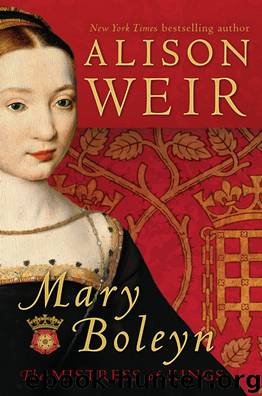Mary Boleyn by Alison Weir

Author:Alison Weir [Weir, Alison]
Language: eng
Format: epub, mobi
ISBN: 9780224089760
Publisher: Jonathan Cape
Published: 2011-01-01T05:00:00+00:00
There have been claims that Henry VIII fathered other bastard children, although only one is based on compelling evidence.71 It has often been said that Henry would have had good reason to acknowledge any natural child born to him, and this has been used as an argument against claims that Mary Boleyn’s children were his. But it seems that Henry had another bastard whom he did not acknowledge, which strengthens the theory that Katherine Carey was his daughter.
In all but that one case, the evidence for Henry’s paternity is slender indeed. In 1592, Sir John Perrot (1528–92), when on trial for high treason, “boasted that he was King Henry’s son.”72 The husband of his granddaughter Penelope Perrot, Sir Robert Naunton (1563–1635), in his Fragmenta Regalia, published posthumously in 1653, also claimed that Perrot was Henry VIII’s son. “Compare his picture, his qualities, gesture, and voice, with that of the King’s, which memory retains yet amongst us,” Naunton wrote. “They will plead strongly that he was a surreptitious child of the blood royal.” The portrait of Sir John Perrot in Haverfordwest Town Museum, Pembrokeshire, certainly does bear a resemblance to Henry VIII.
However, it seems more likely that Sir John was the son of Thomas Perrot, who died in 1531, and whose Inquisition Post Mortem73 shows that his son and heir, John, had been born on November 7, 1529. Yet an inquisition made on April 14, 1549, terminating John’s minority, states that he had reached the age of twenty-one in November 1549, in which month he had been knighted. This is likely to be the more reliable source—inquisitions postmortem were not always accurate—so we may safely assume that Sir John Perrot had been born in November 1528.74
It is unlikely that Henry VIII would have fathered a bastard in February 1528, when he was headily in love with Anne Boleyn and desperate to marry her, and doing his very best to prove to the Pope and the world at large that he was a moral man and that his scruples of conscience over his marriage were genuine ones. At such a crucial juncture he would hardly have risked compromising a happy outcome to his “Great Matter,” or his relationship with his “entirely beloved” Anne (as he called her in a letter sent in June 1528), by taking a mistress. That year, the Pope’s legate, having observed Henry and Anne together, reported to his master: “He sees nothing, he thinks of nothing, but Anne. He cannot do without her for an hour.” Is a man in such thralldom likely to take a mistress? It has been suggested that he did, that he continued “to enjoy other brief, lighthearted affairs,” and that the births of the children that perhaps resulted were probably “accidents.”75 But a closer look at the facts would suggest otherwise.
Thomas Perrot’s wardship had been purchased by Maurice, Lord Berkeley, in 1523. Berkeley had also bought the wardship of his niece, Mary, the daughter of his brother, James Berkeley of Thornbury, Gloucestershire. Mary
Download
This site does not store any files on its server. We only index and link to content provided by other sites. Please contact the content providers to delete copyright contents if any and email us, we'll remove relevant links or contents immediately.
| Africa | Asia |
| Canadian | Europe |
| Holocaust | Latin America |
| Middle East | United States |
Fanny Burney by Claire Harman(25779)
Empire of the Sikhs by Patwant Singh(22166)
Out of India by Michael Foss(16310)
Leonardo da Vinci by Walter Isaacson(11897)
Small Great Things by Jodi Picoult(6087)
The Six Wives Of Henry VIII (WOMEN IN HISTORY) by Fraser Antonia(4785)
The Wind in My Hair by Masih Alinejad(4421)
The Lonely City by Olivia Laing(4113)
The Crown by Robert Lacey(4100)
A Higher Loyalty: Truth, Lies, and Leadership by James Comey(4027)
The Iron Duke by The Iron Duke(3637)
Millionaire: The Philanderer, Gambler, and Duelist Who Invented Modern Finance by Janet Gleeson(3566)
Sticky Fingers by Joe Hagan(3451)
Alive: The Story of the Andes Survivors by Piers Paul Read(3304)
Papillon (English) by Henri Charrière(3265)
Joan of Arc by Mary Gordon(3254)
Stalin by Stephen Kotkin(3082)
Aleister Crowley: The Biography by Tobias Churton(3016)
Ants Among Elephants by Sujatha Gidla(2922)
